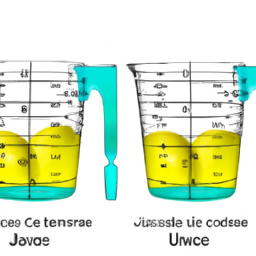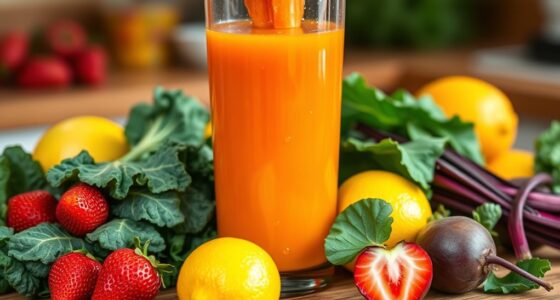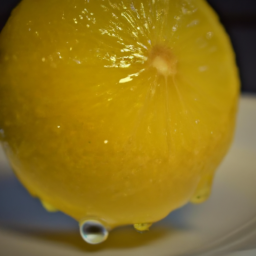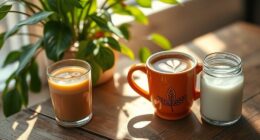Hello! I am excited to share with you my experience of making cabbage juice with a blender. While it may not be the most glamorous drink out there, this juice is packed with health benefits.
Cabbage juice is rich in vitamins, minerals, and antioxidants that can benefit your overall health. Plus, it’s a great way to sneak in some extra veggies into your diet!
Before we get started, let me walk you through the steps to make cabbage juice with a blender. Don’t worry, it’s actually pretty simple and doesn’t require any fancy equipment.
All you need is a blender, a head of cabbage, and a strainer. So, grab your ingredients and let’s get started!
Key Takeaways
- Cabbage juice is a nutritious drink that benefits overall health, digestion, immune system, and weight loss while reducing the risk of chronic diseases.
- Making cabbage juice is simple and only requires a blender, a head of cabbage, and a strainer. Other juices, herbs, and spices can be added to enhance the flavor.
- Cabbage juice is a nutrient-dense vegetable rich in fiber, vitamin C, vitamin K, vitamin B6, and folate, with one cup containing up to 75% of the daily recommended intake of vitamin C.
- To ensure maximum nutrient absorption and best taste, drink cabbage juice immediately after blending and store remaining juice in an airtight container in the fridge. Experiment with adding other fruits/vegetables and spices for variety and increased nutritional value.
Gather Your Ingredients and Equipment
You’ll need to grab all your ingredients and equipment before you can start making cabbage juice. First, let’s talk about the benefits of juicing cabbage. Cabbage juice is an excellent source of nutrients, including vitamin C, vitamin K, and antioxidants. It’s also known to have anti-inflammatory properties that may help reduce the risk of certain diseases. Adding cabbage juice to your diet can help improve digestion, boost your immune system, and even promote weight loss.
Now, let’s move on to the equipment you’ll need. You’ll need a blender, preferably a high-speed blender to ensure the cabbage is blended thoroughly. There are different types of blenders in the market, and it’s essential to choose one that suits your needs. If you’re on a budget, a personal blender can work just fine. However, if you plan on making large batches of juice, a heavy-duty blender with a larger capacity may be more suitable.
Once you have all your equipment, it’s time to prepare the cabbage.
Prepare the Cabbage
First, get your hands on a fresh head of cabbage and chop it into small pieces, remembering the old saying "a stitch in time saves nine."Taking your time to chop it up properly will make blending much easier in the long run.
Cabbage is a cruciferous vegetable that’s rich in vitamins, minerals, and antioxidants. It’s also low in calories, making it a great option for those looking to add more nutritional value to their diet. There are several different varieties of cabbage to choose from, such as green cabbage, red cabbage, and Napa cabbage. Each variety has its own unique flavor and nutritional benefits, so choose the one that best suits your taste and dietary needs.
To prepare the cabbage, follow these steps:
- Remove any wilted or damaged leaves and discard them.
- Cut the cabbage into quarters and remove the core.
- Slice each quarter into thin strips.
- Chop the strips into small pieces.
Once the cabbage is prepared, it’s time to blend it into a juice.
Blend the Cabbage
Now that the cabbage is chopped up, it’s time to throw it in the blender and give it a whirl! To make a tasty cabbage smoothie, add the chopped cabbage into the blender with some water. The amount of water you add depends on how thick or thin you prefer your juice to be.
I usually add enough water to cover the cabbage and blend it until it’s smooth. You can also add some ice cubes to make it more refreshing. Blending the cabbage is an easy and quick way to enjoy its health benefits.
Cabbage is a great source of vitamin K, vitamin C, and dietary fiber. It’s also low in calories and can help with digestion. Once the cabbage is blended, it’s time to strain the juice to remove any chunks or fibers. This will help make the juice smoother and easier to drink.
Strain the Juice
As you pour the blended mixture through a fine mesh strainer, the vibrant green liquid trickles down into the glass, leaving behind any unwanted bits and pieces. Straining the cabbage juice is a crucial step in the process as it removes the fibrous pulp that may not be appealing to some.
There are different straining techniques that can be used such as using a cheesecloth or a nut milk bag, but a fine mesh strainer is the most common option. It’s important to press the pulp against the strainer with a spoon or spatula to extract as much juice as possible.
While straining the juice may seem like a waste of cabbage pulp, there are actually benefits to this process. Consuming a large amount of cabbage pulp can be difficult for some individuals to digest due to its high fiber content. By removing the pulp, the juice becomes easier to digest and the nutrients are more readily absorbed by the body. Additionally, the pulp can be used in other recipes such as soups or stews, so it doesn’t have to go to waste.
Transitioning into the next section, enhancing the flavor of cabbage juice can be done in a variety of ways.
Enhance the Flavor
To truly savor every sip of your homemade cabbage juice, there are a few simple tricks you can use to enhance its flavor. One option is to add other juices to your cabbage juice to create a unique and delicious flavor profile. For example, try adding apple juice, carrot juice, or ginger juice to your cabbage juice for a sweeter and more palatable taste. These additional juices not only improve the taste of cabbage juice, but they also provide extra health benefits as well.
Another way to enhance the flavor of cabbage juice is to add herbs and spices. Adding a small amount of fresh ginger, garlic, or parsley can add depth and complexity to the juice. Additionally, adding a pinch of salt or a dash of lemon juice can help to balance out the flavors and make the juice more enjoyable to drink.
By experimenting with different combinations of herbs, spices, and juices, you can create a customized cabbage juice recipe that is both flavorful and nutritious.
To serve and enjoy your homemade cabbage juice, simply pour it into a glass and sip slowly. Remember to take your time and enjoy the flavors and health benefits that this nutrient-rich juice has to offer.
Serve and Enjoy
Now that the cabbage juice is ready, it’s time to serve and enjoy!
I pour the juice into a glass and make sure to drink it immediately to get the maximum health benefits.
It’s important to note that cabbage juice can oxidize quickly, so it’s best to consume it as soon as possible.
Pour into a Glass
Next, pour the cabbage juice into a glass and enjoy the immense health benefits. Cabbage is a nutrient-dense vegetable that’s rich in fiber, vitamin C, vitamin K, vitamin B6, and folate.
One cup of cabbage juice contains up to 75% of your daily recommended intake of vitamin C, making it a great way to boost your immune system and protect your cells from oxidative stress. Additionally, cabbage juice has been shown to have anti-inflammatory properties, which may help reduce the risk of chronic diseases such as heart disease, diabetes, and cancer.
It’s important to drink the cabbage juice immediately after blending to ensure maximum nutritional value. Vitamin C is a water-soluble vitamin that’s sensitive to heat and light, and it can be easily destroyed during storage or preparation.
To get the most out of your cabbage juice, pour it into a glass and drink it right away. You can also add a squeeze of lemon juice to enhance the flavor and increase the vitamin C content.
Drink Immediately
As you savor the refreshing taste of cabbage juice, remember to drink it immediately to ensure that you receive the maximum health benefits from its powerful nutrients. Here are four reasons why you should drink cabbage juice immediately after making it:
-
Nutrient loss: Cabbage juice is rich in vitamins, minerals, and antioxidants. However, these nutrients are highly sensitive to heat, light, and air, which can cause them to degrade quickly. Drinking cabbage juice immediately after blending ensures that you get the most out of its nutrient-dense goodness.
-
Oxidation: When you expose cabbage juice to air, it undergoes oxidation, which can cause it to spoil quickly. Oxidation also diminishes the nutritional value of the juice. For this reason, it’s essential to drink cabbage juice immediately after blending to prevent oxidation and preserve its freshness.
-
Bacteria growth: The longer cabbage juice sits at room temperature, the more likely it is to develop harmful bacteria. Drinking cabbage juice immediately after blending reduces the risk of bacterial growth and keeps you safe from foodborne illness.
-
Best taste: Cabbage juice tastes best when it’s fresh. Drinking it immediately after blending ensures that you get to enjoy its crisp, refreshing flavor and reap all the health benefits it has to offer.
Now that you’ve enjoyed your freshly made cabbage juice, it’s time to store the remaining juice properly to keep it fresh for later use.
Store the Remaining Juice
Don’t throw away the extra cabbage juice, just stash it in the fridge for later. It’ll be perfect for a refreshing drink or to add some pizzazz to your next smoothie. Preservation techniques are important when it comes to making fresh juice.
The best way to store the remaining juice is to pour it into an airtight container and keep it in the refrigerator. This will help keep the juice fresh and prevent it from oxidizing too quickly. Remember to shake the container before drinking to ensure that the juice is mixed well.
Aside from drinking it, there are a few alternative uses for cabbage juice. You can use it as a base for a salad dressing or marinade, or even add it to soups or stews for an extra boost of nutrients. When using cabbage juice in cooking, remember that it has a strong flavor, so use it sparingly.
Now that you know how to store the remaining juice, it’s time to clean your equipment.
Clean Your Equipment
Now that I’ve successfully made cabbage juice with my blender, it’s important to clean all the equipment properly.
First, I’ll rinse the blender with warm water and soap to remove any leftover cabbage residue.
Then, I’ll wash the strainer thoroughly to prevent any cross-contamination with other foods.
Finally, I’ll clean my workspace to ensure it’s free of any cabbage juice spills or debris.
It’s crucial to clean your equipment properly to maintain the quality of your juice and prevent any bacterial growth.
Rinse the Blender
After blending the cabbage, it’s important to thoroughly rinse the blender to prevent any leftover debris from sticking. Maintaining cleanliness and proper maintenance of your blender will not only ensure its longevity but also safeguard your health. Here are four simple steps to follow when rinsing your blender:
- Begin by removing the blender jar from the motor base and disassembling it into its individual components.
- Rinse each component separately under running water, making sure to remove any cabbage bits or residue that may have accumulated.
- Use a mild detergent and a soft sponge to gently clean the components, taking care not to scratch the plastic or metal surfaces.
- Once you have finished washing the blender, place all the components on a clean towel and let them air dry completely before reassembling.
Now that you have rinsed the blender, the next step is to wash the strainer to ensure that your cabbage juice is smooth and free of any remaining pulp.
Wash the Strainer
First, filter out any remaining fiber by washing the strainer with warm water and a gentle soap, using a soft sponge to scrub away any stubborn particles. Ensure that you clean the strainer thoroughly, as any remaining food particles can cause bacterial growth and affect the taste and quality of your cabbage juice.
After washing, rinse the strainer with clean water and let it dry completely before storing it. Cleaning tips for your strainer include soaking it in a solution of warm water and vinegar to remove any stubborn stains or odors. You can also use a toothbrush or soft-bristled brush to scrub away any remaining particles.
Proper strainer maintenance is essential for making high-quality cabbage juice and ensuring the longevity of your kitchen equipment. With your strainer cleaned and ready to go, it’s time to clean your workspace and prepare for the next step in the cabbage juice-making process.
Clean Your Workspace
To clean your workspace for the next step, you’ll want to clear away any remaining cabbage remnants and wipe down your countertop with a damp cloth. It’s important to have a clean and organized workspace to ensure that your cabbage juice is safe and delicious.
Here are some time management techniques and organizing tools that can help make the cleaning process easier:
- Use a designated cutting board for cabbage to avoid cross-contamination with other foods
- Keep a spray bottle of vinegar and water nearby for quick clean-ups
- Use a plastic bag to collect cabbage scraps for easy disposal
- Keep a container nearby to store your blender parts while you clean them
By following these tips, you’ll be able to quickly and efficiently clean up your workspace and move on to the next step of making your cabbage juice.
Now that your workspace is clean and organized, it’s time to try different variations of the recipe to find your perfect blend.
Try Different Variations
Now that I’ve mastered making cabbage juice with my blender, I’m excited to try different variations.
One option is to add other vegetables or fruits to the mix to create a unique and flavorful juice. Additionally, I’m interested in experimenting with spices to enhance the taste and potential health benefits of the juice.
With these different options, I’m excited to create my own recipes and continue exploring the world of juicing.
Add Other Vegetables or Fruits
If you’re feeling adventurous, why not add some carrots or apples to your cabbage juice blend? Experimenting with different juice combinations can not only add variety to your diet, but also increase the nutritional value of your juice.
Carrots, for instance, are rich in beta-carotene and vitamin A, while apples provide a natural sweetness and are a good source of vitamin C. When adding other vegetables or fruits to your cabbage juice, it’s important to keep in mind the overall flavor profile.
Carrots and apples are great additions that complement the taste of cabbage, but too much of one ingredient can overpower the others. It’s best to start with small amounts and adjust as needed. Once you find a combination that you enjoy, you can continue to experiment with spices to further enhance the flavor.
Experiment with Spices
You can really kick up the flavor of your cabbage juice by experimenting with different spice combinations. Adding spices not only enhances the taste, but also offers various health benefits.
Here are some spice combinations you can try:
-
Turmeric and ginger: Both of these spices have anti-inflammatory properties and can aid in digestion.
-
Cinnamon and nutmeg: These spices add a sweet and warm flavor to the juice, while also helping to regulate blood sugar levels.
-
Cayenne pepper and black pepper: Adding a bit of heat to your juice with these spices can boost metabolism and aid in weight loss.
By incorporating these spices into your cabbage juice, you can not only make it taste better but also reap the many health benefits they offer. After experimenting with different spice combinations, you can create your own recipes and find the perfect flavor that suits your taste buds.
Create Your Own Recipes
Get creative and let your taste buds run wild by concocting your own unique and flavorful cabbage juice recipes that will have you feeling like a master chef in no time! Recipe inspiration can come from anywhere, so try adding some apples for sweetness, carrots for a boost of nutrients, or ginger for a little kick. Experiment with different flavor combinations and see what works best for you. Don’t be afraid to get creative and add your own personal touch to the recipe.
One of the great things about making your own cabbage juice is that you can customize it to your liking. You may prefer a sweeter juice, in which case you can add more fruit or even a little honey. Or perhaps you prefer a more savory drink, in which case you can add some herbs or spices like turmeric or cumin. The possibilities are endless, so have fun with it and see what delicious concoctions you can come up with!
When you’re finished creating your perfect cabbage juice recipe, you can start reaping the benefits of drinking cabbage juice. Drinking cabbage juice has many health benefits, such as improving digestion and promoting weight loss. So, let’s dive into the benefits of drinking cabbage juice and how it can improve your overall health.
Benefits of Drinking Cabbage Juice
Drinking cabbage juice is a fantastic way to boost your immune system and improve digestion. This is thanks to its abundance of health benefits, nutritional value, and probiotics.
Cabbage is an excellent source of vitamins C, K, and B6, as well as folate and manganese. It’s also high in fiber, which promotes healthy digestion and helps to maintain a healthy weight.
In addition to its nutritional value, cabbage also contains antioxidants that help to reduce inflammation in the body. This is particularly important for people with chronic conditions such as arthritis, as it can help to alleviate pain and improve joint function.
Furthermore, the probiotics found in cabbage juice help to promote a healthy gut microbiome. This is crucial for overall health and wellbeing. Drinking cabbage juice regularly can help to improve digestion, boost the immune system, and promote a healthy gut microbiome. Overall, it’s a valuable addition to any health-conscious individual’s diet.
Frequently Asked Questions
How long can cabbage juice be stored in the refrigerator before it goes bad?
Cabbage juice can be stored in the refrigerator for up to 5 days before losing its freshness. To preserve it, store in an airtight container and keep it away from light and heat. It’s like keeping a crisp apple in the fridge.
Can you make cabbage juice with a juicer instead of a blender?
Yes, you can make cabbage juice with a juicer. However, using a blender may retain more of the vegetable’s fiber and nutrients. A nutritional value comparison would depend on the specific juicer and blender used.
Does cabbage juice need to be consumed immediately after being made for maximum health benefits?
Consuming fresh cabbage juice within 30 minutes of making it provides the maximum health benefits. Incorporating cabbage juice into your daily routine can improve digestion, boost immunity, and lower inflammation. Start with small servings and gradually increase intake.
How much cabbage do you need to make a glass of cabbage juice?
To make a glass of cabbage juice, I use a ratio of 1:1 cabbage to water. I blend the cabbage until it is completely liquefied, then strain it through a fine mesh sieve. This ensures maximum nutrient extraction and a smooth consistency.
Can you add other vegetables or fruits to the cabbage juice for additional health benefits or flavor?
Yes, adding ingredients such as carrots, apples, ginger, and turmeric can provide additional nutritional benefits and enhance the flavor of cabbage juice. Carrots are high in vitamin A, apples are a good source of fiber, ginger has anti-inflammatory properties, and turmeric has antioxidant effects.
Conclusion
In conclusion, making cabbage juice with a blender is an easy and effective way to reap the numerous health benefits of this cruciferous vegetable. By following the simple steps outlined above, you can create a delicious and nutrient-packed juice that is perfect for any time of day.
It’s important to note that drinking cabbage juice regularly has been linked to a variety of health benefits. For example, a study published in the Journal of Medicinal Food found that consuming cabbage juice can improve digestion, reduce inflammation, and even help prevent certain types of cancer. Cabbage is also rich in vitamins C and K, as well as fiber and antioxidants, making it an excellent addition to any diet.
So, if you’re looking for a new way to boost your health and wellness, try making cabbage juice with your blender today!
Ilana has been a vegan for over 10 years. She originally made the switch for health reasons, but soon found herself becoming more and more passionate about the ethical and environmental implications of a vegan lifestyle. Ilana is the author of The Graceful Kitchen, a blog all about veganism. She loves to cook up delicious and nutritious vegan meals, and share her recipes with others who are interested in leading a cruelty-free life. Ilana is also a strong advocate for using whole foods as the foundation of a healthy diet, and believes that going vegan is one of the best ways to achieve this.










